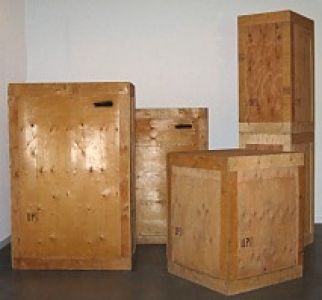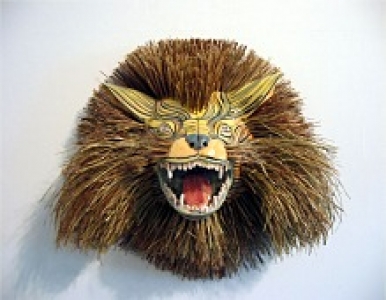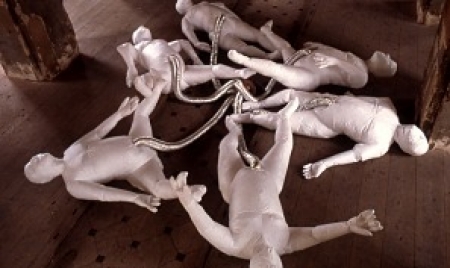Past Exhibition
Three Towns on a River. In- and out-door sculptures
John Dickson
Jim Hong Louie
Max Streicher
July 2002
The Durham Art Gallery has commissioned three site-specific, sculptural installations in the Saugeen River as it winds through the neighbouring towns of Durham, Hanover and Walkerton. John Dickson, Jim Hong Louie and Max Streicher have installed new works that address the symbolic and cultural significance of the river to the communities it has historically linked. The Durham Art Gallery is exhibiting other pieces by the three artists, contextualising their work in the present project.
Gallery curator, Tony Massett, selected the three artists who have each created previous work, which has elements in common with this project:
- John Dickson has employed water as the sculptural focus in his work, evoking an elemental metaphor for the conscious and subconscious relationships to environmental anxiety.
- Jim Hong Louie has created installations which simulate natural phenomena, such as eel migration, and address the symbolic value animals and fish play in various cultures.
- Max Streicher has used the public domain as the backdrop for his inflated sculptures, deploying his giant figures into an architectural and intensely public setting.
The Saugeen River was chosen as the site for this project because it has played a significant role in the commerce and development of the three towns. This artery of trade and communication was the binding force-the symbol of power that drove industry in the area during the nineteenth century. The Walkerton crisis and the Durham flood brought increased attention to the essential role of water in our lives. While rural towns and communities everywhere share many characteristics, this exhibition will mark the Saugeen River as the symbol of our commonality.
John Dickson presented in Durham at the Middle Dam
The house that sinks but also rises. A scale replica of a house roughly 3 feet by 4 feet that will float in the deep water above the dam. Connected to the shore by a rubber umbilicus that leads to an air compressor which, as its brain and lungs, allows the house to submerge on cue and likewise return back to the surface.
The model home as an ideal stable environment is somewhat challenged by this precarious position of floating on water. The housing market in which one floats or sinks, a necessity of circumstances to which we fall victim. Water: the medium of decision and reflex, sink or swim.
Dickson views the challenge of home ownership and the accompanying desire of rearing family, juggling debt and peace of mind, as unstable in an anxious environment.
The dam demands the smothering of vast tracts of land to serve its purpose. One need only observe the Three Gorges Dam in China and the widespread displacement of people, submerging its culture to placate the whims of progress and economic power. Power like the wind, not visible, assessed only by its repercussions.
Jim Hong Louie presented in Hanover, up-stream from the bridge at Karl-Speck-Wilken Park
Four carved, wooden, over life-size Atlantic salmon swim the current in their inevitable quest of instinct and desire.
The Atlantic salmon was at one time a native to these streams and rivers.
The demise of the fish occurred over a hundred years ago due the environmental impact that civilisation had on the landscape. The land locked salmon of the Great Lakes upstream from Niagara Falls evolved into a different fish due to its inability to complete the salt water cycle of its predestined life. The salmon that Louie has contrived is an ideal,the
Jim Hong Louie shared characteristics of both these fish. The work addresses the indomitable spirit and celebration of a species. To anthropromorphise the salmon as an extension of our own desire is to imbue nature with the awe of a spiritual revelation.
Max Streicher presented in Walkerton at the Lobies Park Bridge, Yonge St. North
A large, lightweight inflated head, 14 feet by 10 feet, lolling in the stream of a river, metaphor of continuity and change.
Streicher fabricates his sculptures out of 'Tyvec,' the industrial fabric of a paper-like quality used in the construction industry. Having developed the pattern making skills of a seamstress, the pieces are formed and transformed with the aid of a sewing machine into sculptural forms of a fragile, ephemeral nature.
Working the figure in the monumental continues as a preoccupation, be it a marker or artefact of lost time or ideal. The disembodied head as a Colossus of Rhodes, the demise of culture, or the mind body split. The elevated importance signified in monumentalising the human form, the cult of the personality, or the glorious oppression by the state.
The Head of State or the State of the Head, another ruin, another broken pediment, a lost ideal floating in the stream of unconsciousness.
- Tony Massett, curator



